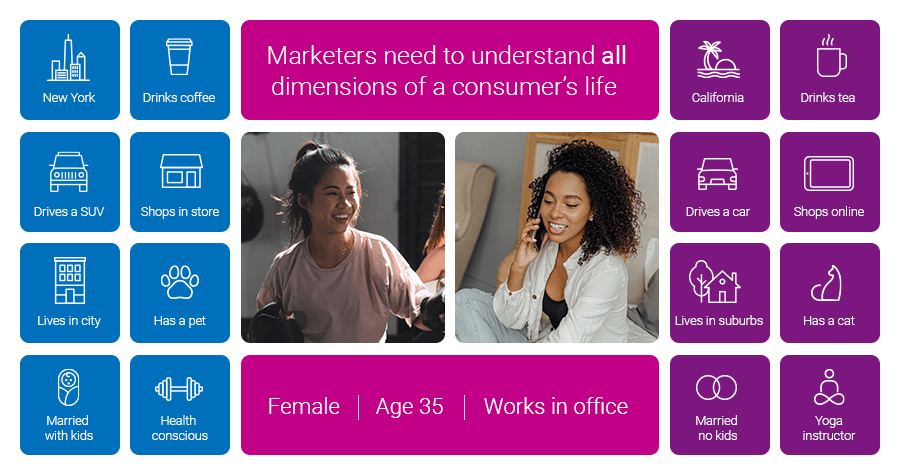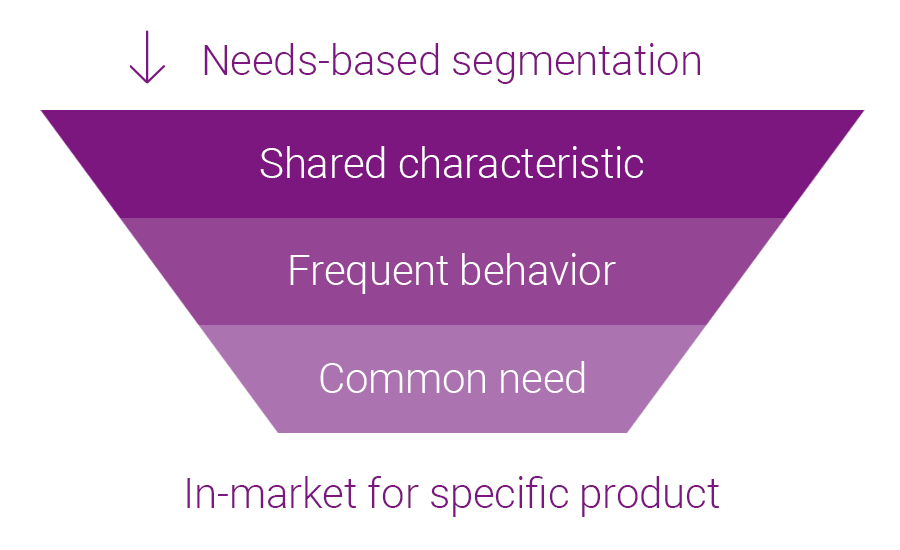Needs-based segmentation overview
How to run your own needs-based segmentation project
Need-based segmentation is the process of grouping people based on their shared needs; instead of grouping them based on data like age or location. Once you identify a common need, you can learn more about why your customers make certain buying decisions based on that need. You can then use this information for targeted ads and personalized marketing strategies.
Grouping people together based on shared characteristics is essential for targeting the right audience and increasing conversion rates. Customer-based segmentation is often based on shared factors such as age, gender, location, behaviors, or needs.
Needs-based segmentation is becoming popular among marketers, and for a good reason. We’ve created an in-depth explanation of needs-based segmentation to show you how it can help you connect precisely with your audiences and inform your marketing strategy.
Why should you consider needs-based segmentation for your marketing strategy? It can increase customer loyalty, create targeted marketing opportunities, and improve product development.
Needs-based segmentation gives you a more in-depth understanding of customer needs so you can build a personalized customer journey with more relatable messaging and tone. Customers are more likely to choose and remain loyal to brands that value their needs.
Needs-based segmentation lets you target specific segments that you can’t find with data-based segmentation alone. You’re guaranteed higher conversion rates when you can target specific segments.
When you know the needs of your customers in the market, you can create better products to meet their needs. This can lead to growth opportunities and higher conversions.
Customer needs indicate why they buy a specific product or service, while value-based segmentation refers to financial value. Knowing a customer’s needs doesn’t offer much guidance if you don’t know the amount your customer is willing to pay to meet their needs.
Other customer-based segmentation strategies, such as data segmentation, have more to do with data such as demographics, geographics, or psychographics. You can find common shared needs by creating segments based on specific characteristics.

Some data is easily accessible for customer segmentation, but other data can require more effort. While collecting your data, determine what information is important for creating useful segments. Some ways to find quality consumer data include contests, social listening, and monitoring store traffic.
Understanding the needs of your customers begins with quality consumer data. You must gain a full picture of your target customer to identify their needs. This is why a unified customer view is essential to deploying needs-based segmentation in your marketing strategy. For example, the needs of a mother of four children will greatly differ from that of a teenage boy. We can help you build your target audience and identify the needs of your ideal customers with our audience insights.
A Job to Be Done (JTBD) is something a customer needs to accomplish under certain circumstances. Some examples include:
Knowing a customer’s JTBD helps you understand what they’re trying to accomplish and what specific products or services will help them. When you know what a group of customers care about, you can solve their exact needs by using relevant ads and gearing your products to their buying mindset.
Analyzing customer behavior, such as purchase history, can inform needs. Looking into what a customer has done in the past and analyzing why they did those things can help you better understand their needs.
Qualitative research is an excellent way to gauge customer needs. The best way to do this is to ask for customer feedback through surveys, reviews, emails, and sales teams.

A customer-based segmentation strategy divides your customer base into groups based on shared characteristics. When you combine needs-based segmentation with other segmentation strategies, such as behavioral segmentation, you can take your targeting to new levels. Knowing their needs and purchasing behavior, you can create more targeted ads and products to benefit them.
Knowing your customers’ needs can help you identify other segments, such as behavior-based. The way customers make purchasing decisions is primarily based on their needs. If you know customer needs, you can create a plan to get them to behave a certain way in the future (i.e., purchasing your product instead of buying from competitors).
Customer segments, like demographics or geographics, can determine the needs of your target audience. People in specific demographics or geographics can share similar needs. For example, young adults with small children who live in areas with a lot of snow often need a vehicle with four-wheel drive large enough to fit the whole family. When you create segments based on demographics, you can often find a common need among these customers.
We can help you create marketing strategies catered to the specific preferences and behaviors of your current and prospective customers. We specialize in helping brands discover data-driven insights to make an everlasting impact on consumers.
Our data and identity products and services can help you learn more about customers and target audiences, leverage data resources, improve targeted marketing, create personalized campaigns, and optimize marketing strategies.
With us, you’ll understand your consumers better, make more effective data-informed decisions, and increase your customer base for bigger revenue.

This site is protected by reCAPTCHA and the Google Privacy Policy and Terms of Service apply.